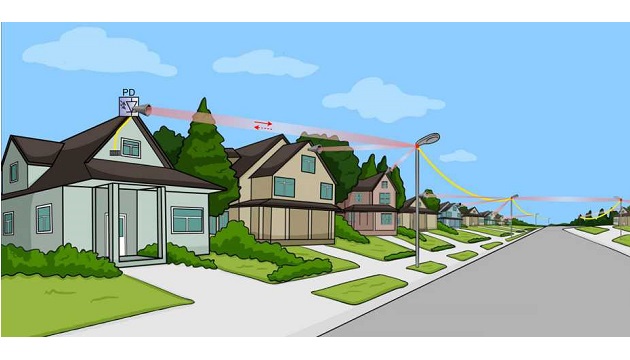While light waves sent through optical fibers support fast data transmission, the “last mile,” from the fiber optic cable to the internet socket in your home, can be the most challenging and expensive leg of the journey. In the future a new light modulator developed by researchers at ETH Zürich, with support from the University of Washington, could cover the “last mile” where data must travel efficiently and at a low cost.
The modulator consists of a chip that contains the microwave antenna. The antenna receives the high-frequency microwaves, or millimeter waves, used for the data transmission and converts them into an electric voltage.
At the heart of the modulator is a narrow slit, just a few micrometers long and less than 100 nm wide. The slit is filled with a material that is sensitive to electric fields. A light beam from the fiber is fed into the slit. Inside the slit, the light propagates not as an electromagnetic wave, but as a plasmon. Plasmons, hybrids made of electromagnetic fields and oscillations of electric charge at the surface of a metal, can be confined much more tightly than light waves.
The electrically sensitive, nonlinear material inside the slit ensures that even the tiniest electric field created by the antenna will strongly influence the propagation of the plasmons. The antenna’s influence on the oscillatory phase of the waves is conserved when the plasmons are converted back into light waves at the end of the slit. The plasmonic mixer directly maps the wireless information onto optical signals. The data bits contained in the high-frequency millimeter waves are transferred directly onto the light waves.
The light modulator works entirely without batteries and expensive electronics. “That makes our modulator completely independent of external power supplies and, on top of that, extremely small so that it can, in principle, be mounted on any lamppost,” said researcher Yannick Salamin. “From there, it can then receive data via microwave signals from individual houses and feed them directly into the central optical fiber.”
In addition to its compact size and low energy consumption, the new modulator has further advantages. “The direct transfer from millimeter waves to light waves makes our modulator particularly versatile regarding the frequency and exact format of data encoding,” said professor Jürg Leuthold.
In contrast to the radio waves or microwaves of a Wi-Fi modem, which propagate evenly in all directions, millimeter waves can be focused to propagate just between the roof antenna and a light pole inside a beam that is 20 cm in diameter. This could significantly reduce the power needed for transmission, compared to other wireless technologies. It could also eliminate the typical problems of Wi-Fi modems, whose signals can get in each other’s way.









